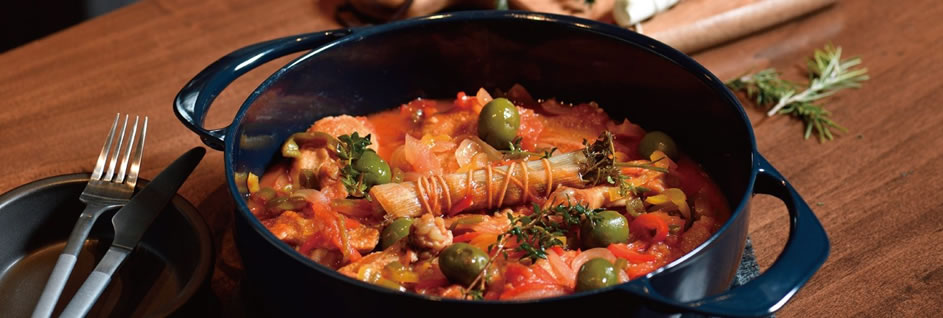What is an Enameled Pot?
Made of strong hard iron in addition to beautiful glass offering excellent wear-resistance and non-adsorption, many people love enameled pots.
Enameled pots have their own history, advantages, disadvantages and maintenance.
Types
We live in a world full of many different pots. Non-stick coating pots, aluminum pots and iron pots are often seen. Other pots include stainless steel, titanium, copper, clay, glass and enamel pots. Made of different materials, they all have different characteristics.
In case of Japanese market, pots whose main bodies are metal are coated with non-stick. That is, the base is made of aluminum or stainless steel coated with non-stick. These are seen the most often, followed by aluminum, iron, stainless steel, copper and titanium. Non-metal pots are made of clay and glass. Although the types of non-metal pots are limited compared to metal pots, many homes in Japan have at least one clay pot.
An enameled pot, combining metal and glass, is an iron pot coated with glass enamel.
Enamel

History of Enamel
The oldest enamel product in the world was excavated on Mykonos Island in the Aegean Sea. The year is estimated to be around 1425 BC. This ancient artifact had a hole in a golden surface that was filled with blue glass enamel. After that, this technology divided into two; one was on Cyprus Island to the east and the other on the mainland in Greece to the west. One propagated to Germany, France and other parts of Europe and the other to Asia through the Middle East and finally to Japan via China and the Korean Peninsula.
In Japan, Yozaemon Hirose, who was a man from Kuwana of Ise, started coating cast iron with enamel to make industrial products in 1866.
Production and sale of enameled cast iron pots started in the Meiji era (1868-1912), followed by the manufacturing and sale of enamel glaze soon after. In 1881, enameled cast iron was exhibited at the Kangyo Expo in Ueno, Tokyo, which attracted the attention of many people. Thus, the history of Japanese enameled products started from enameled cast iron.
Enamelware for general use was sold with the name of “seto-biki”, which has multiple meanings including enamelware, after the exhibition. In the middle of the Meiji era a technical term, “horo”, was adopted to sell the products, which sparked the spread of the word “horo”, specifically meaning enamelware.
In the early days, there were inferior products, giving the impression that enamel is easy to peel off. The quality improved greatly after that and the strength against shock increased. As a result, enamel is now used for pots, bathtubs, tanks, chemical equipment, combustion equipment, construction materials and medical instruments.
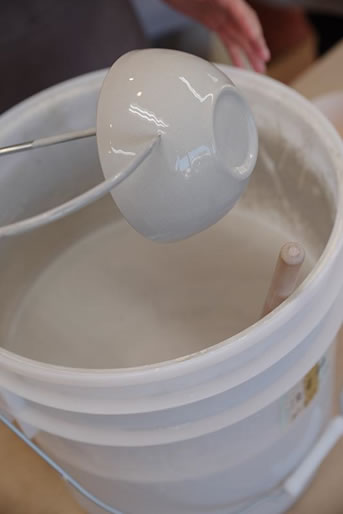
About Enamel
Enamel refers to both the glaze that was completely attached to the product when it was fired in the kiln on metal and the finished product. When differentiating, it is necessary to use expressions such as enamel coating, enamelware and enamel processed, which are also used overseas.
Enamelware in General
Enamelware is metal covered with inorganic glass as coating on the surface and then fired in a kiln. It consists of two layers: a lower layer and an upper layer. The lower layer has glass on the casting or steel; this glass is to adhere to the metal. The upper layer is a composition glass that serves the desired functions such as chemical properties, heat resistance and decorative properties.
In the manufacturing process, these glasses are melted separately and made into a glass and silica powder, which is called frit. The frit is applied to a metal surface and then re-melted by heating. At this time, a reaction occurs between the molten glass and the metal surface, making the interface uneven. This unevenness makes the glass layer and iron firmly adhere to each other.
The firing temperature is 800 to 850° C. The firing time is 5 to 10 minutes. It is created in a relatively short time at a relatively low temperature compared to ceramics.
Coating (Glaze)
Inorganic glass coating is created by mixing lime, feldspar, clay, silica stone, borax, fluorite and metal oxides to make frit as a raw material. Then clay and adjustment materials are mixed with the frit and crushed.
The processes of applying this enamel glaze to metal products, drying and firing are done in the order of the first coat of glaze, the second coat of glaze and then the painting to make an enamelware.
Enamel uses the same glaze as pottery.
Metal selected to make enamelware should not melt at firing temperature, rust rapidly, generate a large amount of gas or become deformed. It has to have good welding workability. Most of the metals currently used for enamelware include iron, which is in steel plate for enamelware and cast iron.
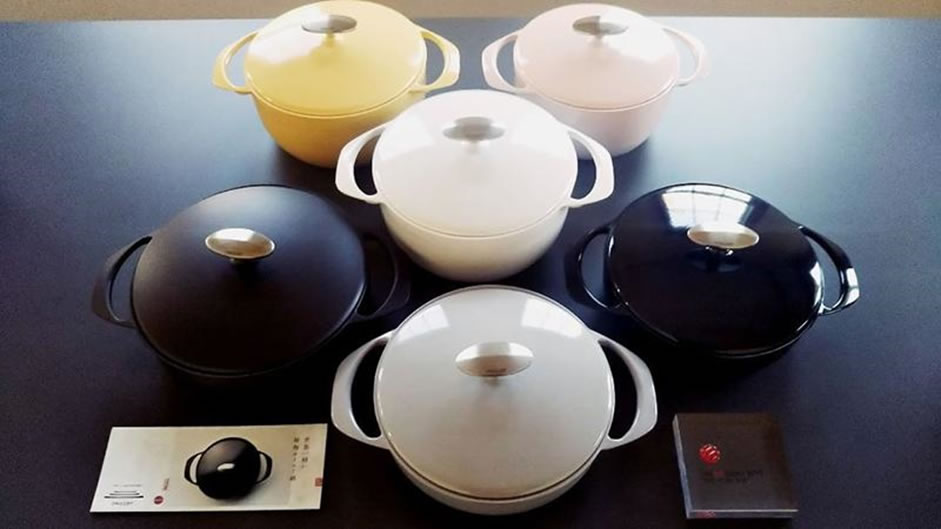
Strengths and Advantages of Enameled Pots
Enameled pots made by combining two completely different materials of iron and glass draw on the good features of both materials.
Enamel combines the properties of hard and strong iron with glass that is beautiful, corrosion-resistant, wear-resistant and non-adsorbing.
Heat Resistance and Retention
Because the metal base is coated with glass, it has high heat resistance and excellent heat retention. Heat transmission is slower than other products, making the food surface strong when it is cooked and helping the final dish to maintain its shape, making the food light and fluffy.
Corrosion and Acid Resistance
With the metal base covered with glass, enamel resists rust and corrosion. UNILLOY products in particular are coated entirely with glass, unlike some other enameled cast iron pots. There is no need to wipe off an exposed metal base after use.
In addition, the coated glass is strong against acids and salt and does not transfer odor. Therefore, you can store food with strong odors such as braised pickles, sake lee pickles, which are made from sake mash, and miso without worrying about discoloration.
The Color Keeps for a Long Time
One old enamel item is King Tutankhamen’s golden mask made long before Christ. It remains beautiful from that time without losing color after many years.
Even if enamel is used in harsh environments such as building exteriors and billboards, changes in color and gloss are minimal because it is colored in glass. You can enjoy the beautiful colors for a long time.

Durability and Abrasion Resistance
Since the base metal and coated glass are heated and re-melted when making enamelware, the molten glass layer and iron firmly adhere to each other.Adhesion and durability are extremely high.
Taking advantage of these characteristics, enamel is also used for bathtubs and construction materials.
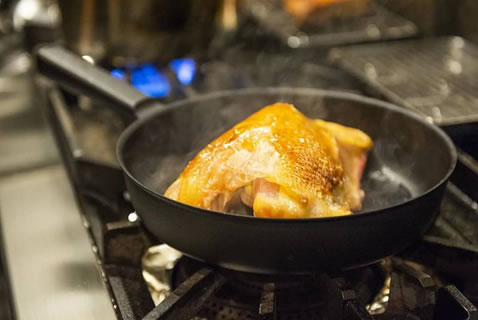
Enameled cast iron and Enameled steel plate Pots
The iron base used for enameled pots is broadly divided into two categories: one is made of steel plate and the other is cast iron. Below are the differences in production.
Steel plate Pots
The material is formed into a steel pot by cutting and processing what was originally coiled steel. Because it is made by processing steel plate, there is no freedom in shape compared to cast iron, but the products are lighter.
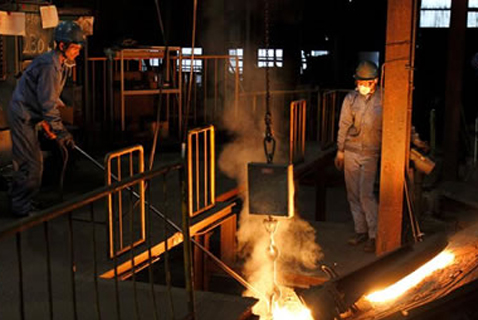
Cast Iron Pots
The pot is made by heating and melting metal and pouring it into a mold. The material is taken out from the mold after cooling and solidifying.
It takes less time and effort compared to steel plate pots because molten metal is poured into molds to make the shape. This method has long been used to process metal products.
Compared to steel plate pots, cast iron pots transmit heat more slowly, enabling thorough cooking. Cast iron pots also have excellent heat storage. Therefore, when sautéing, the ingredients do not harden and the food becomes delicious. The pot is also suited for cooking simmered dishes and soups.
Since it is heavier than a steel plate pot though, it is inconvenient for daily use.
Many Dutch ovens and skillets used outdoors are also made of cast iron. People tend to avoid using them daily because of the weight and maintenance.
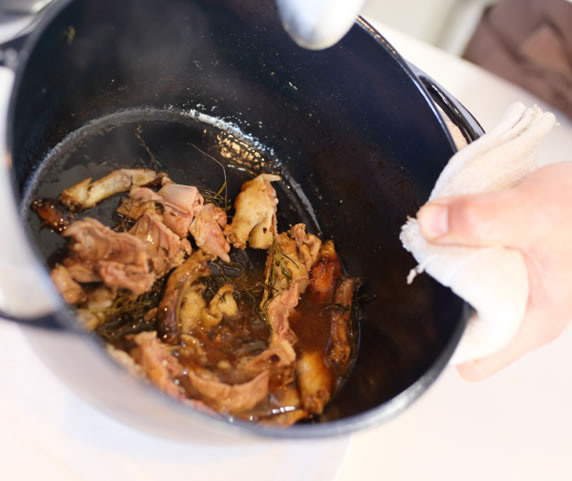
Our UNILLOY enameled pots were developed to eliminate the disadvantages of enameled cast iron pots being heavy and hard to use. We wanted to make the pots as light as possible so that people could easily use them daily. The development of the world’s lightest enameled cast iron pot was a series of extraordinary efforts, trial and error. However, with the ideal lightness and attractiveness that fit into life, our Japanese enameled cast iron pot astonished and caught the eyes of professionals around the world, including Europe and the United States. UNILLOY delivers an inspiring culinary experience to people all over the world through the world’s lightest enameled cast iron pot.
How to Use and Maintain Enameled Pots
Enameled pots have the good features of both metal and glass. Since the core material is metal, they are highly durable. Covered with glass coating, they are also hard to burn. They are quite sturdy, but still need to be handled properly. After all, even a sturdy enameled pot can be scratched or damaged.
How to use
- With the exception of waterless cookers dedicated to waterless cooking, which is cooking using the moisture of the material, usually without adding any water, waterless cooking can lead to heating an empty pot depending on how you cook. If an empty enamel pot is heated, the enamel on the surface may chip or the coating peel off, causing a fire. If you follow the attached recipe or any reliable and appropriate recipe, paying sufficient attention not to heat an empty pot, you can also use enameled pot for waterless cooking.
- The glass coating may crack or break if the pot is dropped or bangs against anything. Be very careful when handling it.
- When aluminum or stainless steel cooking utensils such as ladles and turners are used, you may leave gray lines on the enamel.
Aluminum and stainless steel are softer than enamel; the metal scrapes off and adheres to the enamel.
Wooden or silicon cooking utensils are recommended.
Maintenance
- Do not use a metal scrubber or abrasives. They will damage the surface glass. When removing dirt, use a neutral detergent and wash with a soft sponge to avoid scratching.
- Alkaline detergents such as dishwasher detergent and chlorine bleach may also damage the enamel gloss and accelerate deterioration.
- Wipe off the water as much as possible after washing enamelware. Drying prevents rusting and dirting.
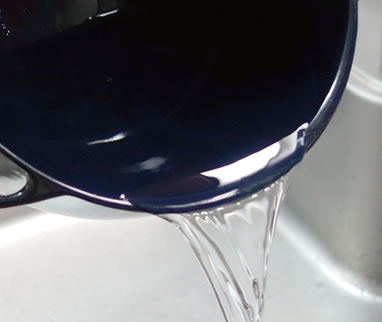
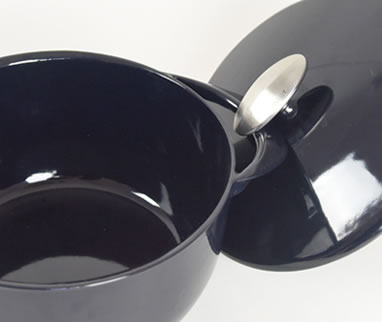
With proper use and maintenance, you can keep your enamelware in good condition for a long time.
UNILLOY will re-enamel the pot if it is chipped or discolored for a fee. We would like our customers to use our pots for many years.
“Matt black” is also in the UNILLOY lineup. This is more resistant to damage when dropped or banged against something as well as burns in addition to being light compared to conventional products. For more information, please click the button below to see our product lineup.

